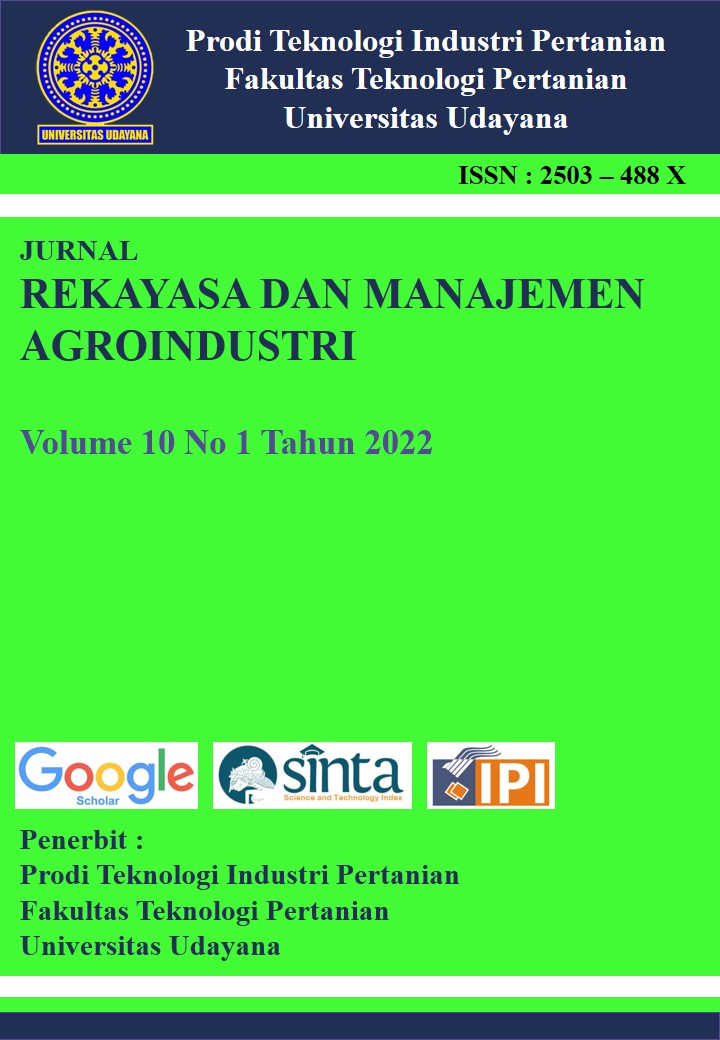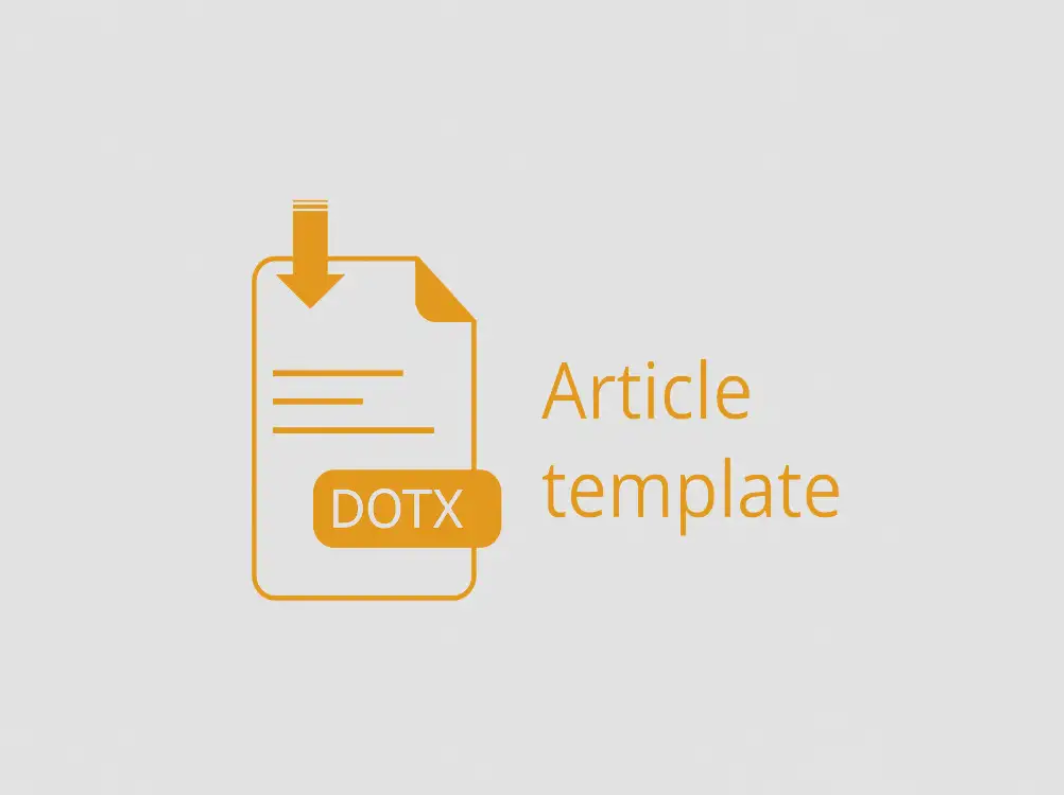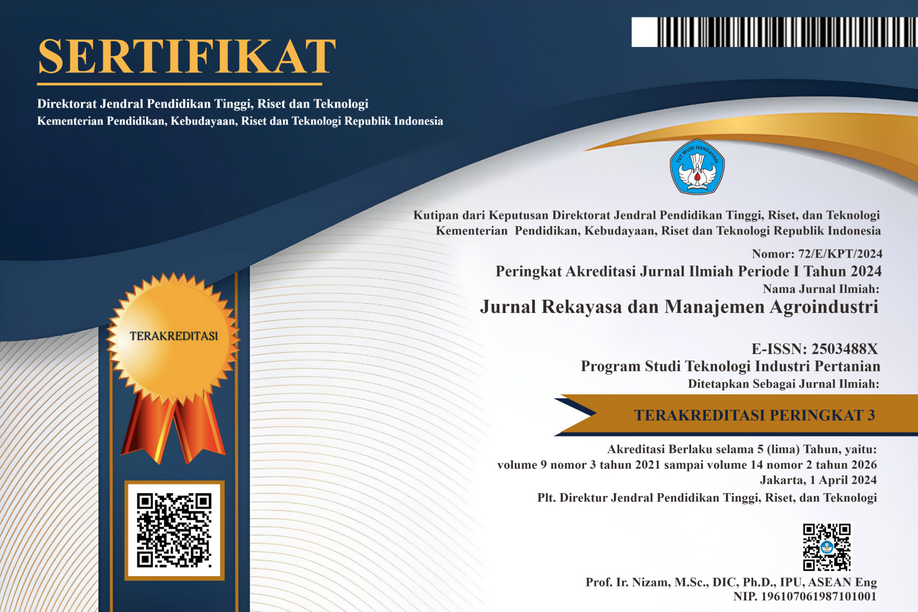Pengaruh Rasio Campuran Surfaktan dan Minyak Atsiri Jahe (Zingiber Officinale Var. Amarum) terhadap Karakteristik Mikroemulsi yang Dihasilkan
Abstract
This study aims to determine the effect of the mixture ratio of surfactant and ginger essential oil on the characteristics of the resulting microemulsion and determine the best ratio of surfactant and ginger essential oil mixture to obtain the best microemulsion characteristics. This experiment used a simple randomized block design (RAK) with a mixture ratio of surfactant and ginger essential oil: 100:0; 98:2; 96:4; 94:6; 92:8; 90:10; 88:12; 86:14; 84:16; 82:18. Data were analyzed using analysis of variance and continued with the BNJ test. The best treatment was the highest ratio of ginger essential oil which still formed microemulsion. The microemulsion with the best ratio was tested for stability against pH and dilution during 8 weeks of storage with observations every 2 weeks. Data were analyzed using linear regression to determine the stability of ginger essential oil microemulsion. The results showed that the ratio of the mixture of surfactants and ginger essential oil had an effect on the characteristics of the resulting microemulsion. The ratio of surfactant and ginger essential oil 96:4 is the best treatment for making ginger essential oil microemulsion with the characteristics of having a transparent microemulsion appearance, turbidity index values before and after centrifugation of 0.225±0.011% and 0.294±0.008% and having a particle size of 12, 5±5.0 nm, the largest droplet size was 11 nm, and was stable for 8 weeks of storage.
Keywords: microemulsion, surfactant, ratio, Zingiber Officinale var. Amarum
Downloads
References
Cho, Y. H., S. Kim, E. K. Bae, C. K. Mok, and J. Park. 2008. Formulation of a cosurfactant-free m/a microemulsion using nonionic surfactant mixtures. Journal of Food Science. 73(3):115 -121.
Cui, J., B. Yu, Y. Zhao, W. Zhu, H. Li, H. Lou, and G. Zhai. 2009. Enhancement of oral absorption of curcumin by self-microemulsifying drug delivery systems. International Journal of Pharmaceutics. 371(1): 148-155.
Dai, J., S. M. Kim, I. S. Shin, J. D. Kim, H. Y. Lee, W. C. Shin and J. C. Kim. 2013. Preparation and stability of fucoxanthin-loaded microemulsions. Journal of Industrial and Engineering Chemistry 1574: 1-8.
Fletcher, P. D. I., and J. S. Morris. 1995. Turbidity of oil-in-water microemulsion droplets stabilized by nonionic surfactants. Colloids Surfaces A: Physicochem. Eng. Aspects 98 (1995):147-154.
Goulart, F. S. 1995. Super Healing Foods. Reward Books, a member of Penguin Putnam, New York.
Hernani dan C. Winarti. 2002. Kandungan Bahan Aktif Jahe dan Pemanfaatannya dalam Bidang Kesehatan. Balai Besar Penelitian dan Pengembangan Pascapanen Pertanian, Bogor.
Jufri, M., J. Djajadisastra, dan L. Maya. 2009. Pembuatan mikroemulsi dari minyak buah merah. Majalah Ilmu Kefarmasian. 6(1): 18 – 27.
Khalida, N. S., R. Annisa, dan Y. Y. A. Indrawijaya. 2019. Karakterisasi dan Uji Pelepasan Mikroemulsi Topikal Natrium Diklofenak Menggunakan Virgin Coconut Oil (VCO) Sebagai Fase Minyak. Skripsi. Tidak Dipulikasikan.Fakultas Kedokteran dan Ilmu Kesehatan, Universitas Islam Negeri Maulana Malik Ibrahim Malang, Malang.
Kurniasari, I., I. Hartati, R. D. Ratmani, dan I. Sumantri. 2008. Kajian ekstraksi minyak jahe dengan microwave assited extraction (MAE). Momentum. 4(2): 47-52.
Martin, A., J. Swarbrick, dan A. Cammarata. 1993. Farmasi fisik jilid 2 Edisi III. Terjemahan dari Physical Pharmacy, Physical ChemicalPrinciples in the Pharmaceutical Scienes. UI-Press, Jakarta.
McClements, D. J. and E. A. Decker. 2000. Lipid oxidation in oil-inwater emultions: impact of molecular environment on chemical reaction in heterogeneous food system. Journal of Food Science. 65(8): 1270-1282.
Pairul, P. P. B., Susanti, dan H. N. Syahrul. 2017. Jahe (Zingiber Officinale) sebagai anti ulserogrnik. Medula. 7(5): 42-46.
Permana, I. D. G. M., dan L. Suhendra. 2015. Optimasi konsentrasi VCO dalam mikroemulsi m/a dengan tiga surfaktan sebagai pembawa senyawa bioaktif. Media Ilmiah Teknologi Pangan (Scientific Journal of Food Technology). 2(2): 106-114.
Rao, J., and D. J. McClement. 2011. Formation of flavor oil microemulsions, nanoemulsions and emulsions: influence of composition and preparation method. Journal of Agricultural and Food Chemistry. 59: 5026-5035.
Rusli, M. 2010. Sukses Memproduksi Minyak Atsiri. Argo Media Pustaka, Jakarta.
Santoso, H. B. 2008. Ragam dan Khasiat Tanaman Obat. PT Agromedia Pustaka, Yogyakarta.
Sari, K. D., dan R. S. D. Lestari. 2015. Pengaruh waktu dan kecepatan pengadukan terhadap emulsi minyak biji matahari (Helianthus annuus L.) dan air. Jurnal Integrasi Proses. 5(3): 155-159.
Schoenwald, R. D., and D. R. Flnagan. 1989. Bioavailability of Disperse Dosage Forms. Dalam: Lieberman HA, M. M. Rieger and G. S. Banker, eds. Pharmaceutical Dosage Forms: Disperse Systems.Vol.2. Marcel Dekker Inc., NewYork: 115-117.
Setyawan, B. 2015. Budidaya Umbi-Umbian Padat Nutrisi. Pustaka Press, Yogyakarta.
Shargel, L., dan A. B. C. Yu. 1988. Biofarmasetika dan Farmakokinetika Terapan. Universitas Airlangga Press, Surabaya.
Sucitawati, P. A., L. Suhendra, dan G. P. G. Putra. 2021. Karakteristik mikroemulsi α-tokoferol pada perbandingancampuran tiga surfaktan nonionik dan lama pengadukan. Jurnal Rekayasa dan Manajemen Agroindustri. 9 (1): 33-41. https://doi.org/10.24843/JRMA.2021.v09.i01.p04.
Suhendra, L., S. Raharjo., P. Hastuti, dan C. Hidayat. 2012. Formulasi dan stabilitas mikroemulsi o/w sebagai pembawa fucoxanthin. Agritech. 32 (3): 230-239.
Suhendra, L., S. Raharjo., P. Hastuti, dan C. Hidayat. 2014. Stabilitas mikroemulsi fucoxanthin dan efektifitasnya dalam menghambat foto oksidasi vitamin c pada model minuman. Agritech. 34 (2): 138-145.
Sutamaya, N. I. K., I. D. G. M. Permana dan I. K. Suter. 2018. Stabilitas mikroemulsi VCO dalam air pada variasi HLB dari tiga surfaktan selama penyimpanan. Jurnal Ilmu dan Teknologi Pangan. 7 (4):184-191. https://doi.org/10.24843/itepa.2018.v07.i04.p05.
Talegaonkar, S., A. Azeem, F. J. Ahmad, R. K. Khar, S. A. Pathan, and Z. I. Khan. 2008. Microemulsions: a novel approach to enhanced drug delivery. Recent Patents on Drug Delivery and Formulation. 2(2):238-257.
Widiastuti, N. 2010. Formulasi Mikroemulsi Topikal Menggunakan Fase Minyak Virgin Coconut Oil (VCO) dan Isopropil Laurat dengan Natrium Diklofenak sebagai Model Obat. Skripsi. Tidak Dipublikasikan. Fakultas Matematika dan Ilmu Pengetahuan Alam, Universitas Indonesia, Depok.
Wulandari, S. A. R. 2017. Formulasi dan Uji Aktivitas Antibakteri Stapylococcus epidermidis Sediaan Mikroemulsi Ekstrak Daun Kersen (Muntingia calabura Linn.) dengan Fase Minyak Isopropil Mirystate. Skripsi. Tidak Dipublikasikan. Fakultas Kedokteran dan Ilmu-ilmu Kesehatan. Universitas Islam Negeri Maulana Malik Ibrahim, Malang.

Ciptaan disebarluaskan di bawah Lisensi Creative Commons Atribusi-BerbagiSerupa 4.0 Internasional.
Seluruh artikel di Jurnal ini dapat disebarluaskan atas tetap mencantumkan sumber yang syah. Identitas judul artikel tidak boleh dihilangkan. Penerbit tidak bertangggung jawab terhadap naskah yang dipublikasikan. Isi artikel menjadi tanggung jawab Penulis.














